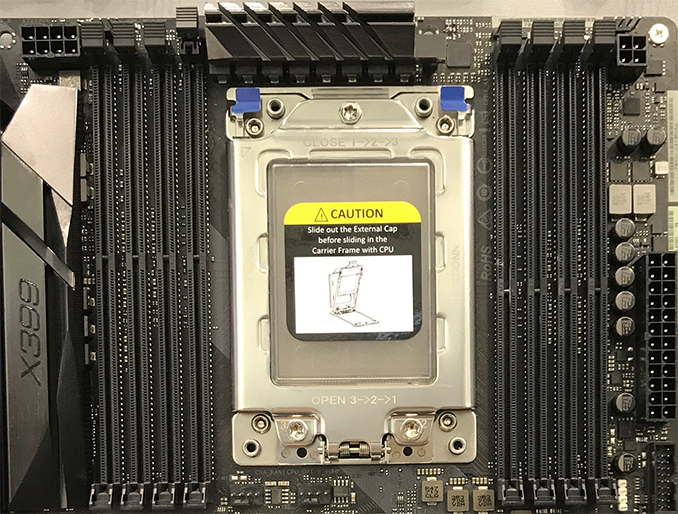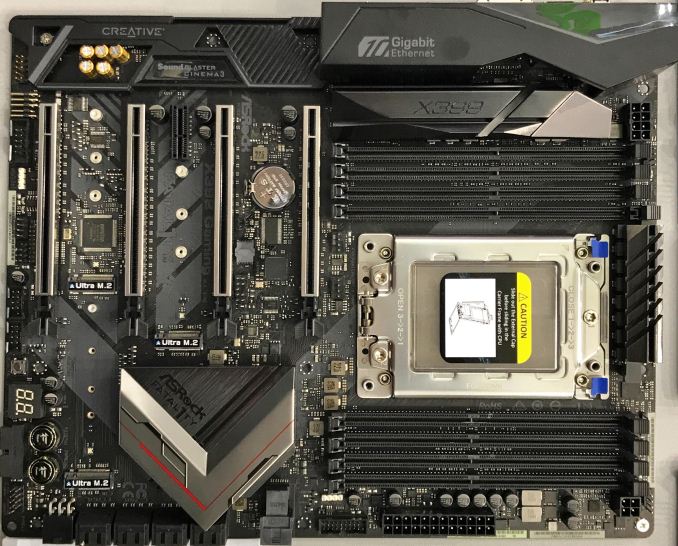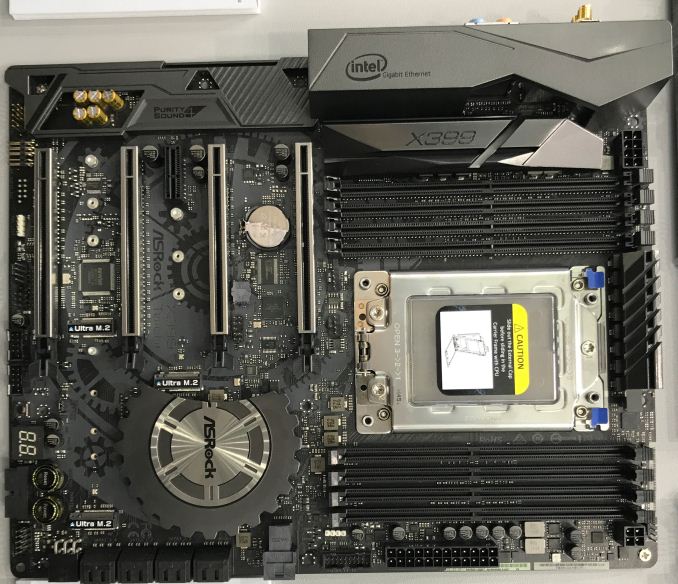ASRock Demos X399 ‘ThreadRipper’ Motherboards: M.2, U.2, 10 GbE, & More
by Anton Shilov on June 7, 2017 10:00 AM EST- Posted in
- Motherboards
- AMD
- ASRock
- Trade Shows
- Ryzen
- Computex 2017
- ThreadRipper
- X399

At Computex last week, ASRock demonstrated two motherboards designed for AMD’s upcoming ThreadRipper HEDT processors. The new platforms are for high-end workstations and designed to support up to four graphics cards though the 60 PCIe lanes from the CPU, over a dozen of storage devices and up to eight DIMMs. To a large degree, ASRock’s motherboards reflect overall positioning of the AMD X399 “ThreadRipper” platform as a premium high-end desktop play, and what to generally expect from makers of mainboards here.
ASRock plans to offer two motherboards for AMD’s ThreadRipper CPUs: the X399 Professional Gaming and the X399 Taichi. The mainboards are based on the same PCB (and the same AMD X399 chipset/socket), but have a slightly different feature set. The ThreadRipper motherboards that ASRock demonstrated at Computex featured an eight-phase digital CPU VRM, which is the feasible limit given the physical space available, but we have no idea the capabilities of the power delivery as of yet. ThreadRipper is meant to be a high performance, high power processor, so undoubtedly the motherboard vendors have built their boards to match. When it comes to the socket itself, it has 4094 pins and is very large (not surprising given its origin). We've seen the socket referred to as SP3r2 and TR4, although the official word from AMD is that it is the 'X399 platform'.
It will be interesting to see whether any motherboard maker manages to design a Mini-ITX mainboard for the ThreadRipper, but we will see. As we understand it, one of the problems with the socket, apart from the dimensions, is its cost to manufacturers that is prohibitively high at this time.
Both of the X399 motherboards from ASRock have eight DDR4 memory slots, but the manufacturer does not disclose speeds, ECC support and other details (although given previous discussions, we expect at least ECC and DDR4-2400). In fact, it does not even reveal the maximum amount of memory supported by the CPU. Though even if the company does know, it's almost certain that AMD wants to hold all of these cards close to their chest for future product announcements.
The X399 Professional Gaming physically has four PCIe 3.0 x16 slots (electrically set at two x16 and two x8) that can support up to four-way AMD CrossFireX or NVIDIA SLI multi-GPU configurations, as well as PCIe SSDs. In addition, there is a PCIe 3.0 x1 slot. As for storage options, ASRock has most configurations covered: the motherboard carries eight SATA ports, a U.2 connector, as well as three M.2 slots. To ensure that there is enough power for the latter, there is a 6-pin PCIe power connector right near the SATA ports. As for network connectivity, the motherboard features a 10 GbE port using Aquantia's AQC solution, two GbE headers (enabled by Intel controllers), as well as a 2x2 802.11 Wi-Fi module with Bluetooth. As for USB, there are 10 USB 3.0 ports in addition to two USB 3.1 ports (Type-A and Type-C) on the back panel. Finally, the X399 Professional Gaming has a 7.1 audio sub-system enhanced using Creative Labs’ SoundBlaster software.
| ASRock's X399 Professional Gaming and X399 Taichi for AMD ThreadRipper CPUs | |||
| X399 Professional Gaming | X399 Taichi | ||
| CPU Support | AMD ThreadRipper CPUs in LGA4094 form-factor | ||
| Graphics |
4 × PCIe 3.0 x16 (2 × x16, 2 × x8) |
||
| Chipset | AMD X399 | ||
| Memory | Eight DDR4 DIMM slots | ||
| Ethernet | 1 × 10 GbE Aquantia AQtion AQC107 2 × Intel GbE controllers |
2 × Intel GbE controllers | |
| Storage | 8 × SATA 6 Gbps 3 × M.2 (PCIe 3.0 x4 or SATA) 1 × U.2 (PCIe 3.0 x4) |
||
| Audio | Realtek ALC1220 (?) 7.1 channel audio with Creative Labs SoundBlaster Cinema 3 enhancements |
Realtek ALC1220 (?) 7.1 channel audio with ASRock Purity Sound 4 |
|
| USB | 8 × USB 3.0 Type-A 1 × USB 3.1 (Gen 2) Type-A 1 × USB 3.1 (Gen 2) Type-C |
||
| Other I/O | Dual band 802.11ac Wi-Fi + Bluetooth 4.x, PS/2 | ||
| Form-Factor | ATX | ||
| MSRP | Expensive | Less Expensive | |
It is worth nothing that we expect the X399 chipset to be as capable as the AM4 X370 platform, which means that some of the features on the motherboard are likely to have shared resources, meaning having one enabled will disable some others. AMD has engineered the CPU to have 60 PCIe lanes for storage and graphics, which will nominally mean most configurations will allow three GPUs (totalling 48 lanes) and three M.2 slots (totalling 12 lanes) although the 10GbE controller will require some lanes as well as the other Ethernet and perhaps a USB port controller or two. Until we see the chipset diagram, it will be hard to tell at this point.
The ASRock X399 Professional Gaming and the X399 Taichi will be available later this year when AMD releases its ThreadRipper CPUs. It goes without saying that the motherboards are not going to be cheap: they are not designed for general consumers and their server origin will have a direct impact on pricing.
Related Reading:
- AMD CPU Updates: 16 Core ThreadRipper w/64 PCIe Lanes This Summer, Epyc Launching June 20th
- AMD Announces Ryzen AGESA 1.0.0.6 Update: Enables Memory Clocks Up To DDR4-4000
- Computex 2017: AMD Press Event Live Blog
- ASRock Announces X299 Professional Gaming i9 with 3-Way Multi-GPU, 10Gb Ethernet, & Wi-Fi
- Intel Announces Skylake-X: Bringing 18-Core HCC Silicon to Consumers for $1999
- Intel Announces Basin Falls: The New High-End Desktop Platform and X299 Chipset
Source: ASRock












69 Comments
View All Comments
Krysto - Wednesday, June 7, 2017 - link
"Funny" is not the right word. The right word is probably "antitrusty".Intel is likely using illegal shenanigans again to hurt AMD in every way it can. In this case, maybe get Asrock not to make so many motherboards, and put its logos on the ones it has.
HomeworldFound - Wednesday, June 7, 2017 - link
This is why AMD isn't that popular, it's fans are all conspiracy theorists.Hurr Durr - Thursday, June 8, 2017 - link
"Conspiracy theorist" is a pathetic canard introduced by media when it has absolutely nothing to say.What actually plagues those AMD fanatics is their victim culture. Muh ebil intel opresshun oy vey.
close - Thursday, June 8, 2017 - link
@HomeworldFound and @Hurr Durr It's not like Intel was officially found to have used illegal and anti-competitive practices for years in a successful attempt to keep AMD's market share as small as possible specifically by... "motivating" potential partners into avoiding AMD.The problem with internet commentators these days is that they have all sorts of personal opinions and the fact that they can share them with everyone suddenly turns them into facts. Jacks of all trades (masters of none).
Strunf - Thursday, June 8, 2017 - link
It's not cause Intel has been found guilty that now everything they do is close to illegal.Don't you think the FACT Intel has good network controllers (acknowledge by the industry) that makes it worth to advertise it?...
close - Thursday, June 8, 2017 - link
Do you see any mention of Intel logos in my comment? That's because I had nothing to say about that topic :). Come to think of it I also didn't suggest that everything they do is (close to) illegal. Just that they have a track record of breaking the law so thinking they *may* do it again is a legitimate concern, not a conspiracy theory.HomeworldFound - Thursday, June 8, 2017 - link
I know that, but to suggest it still continues just because of an Intel label above the rear ports where other manufacturers label their NIC too is pretty silly. I can't see how that's "antitrusty" or "Intel is likely using illegal shenanigans again to hurt AMD in every way it can."The last thing Intel wants is to go through that again, and yes the comment is very conspiratorial.
Timoo - Wednesday, June 21, 2017 - link
To be honest, I doubt that. The net gain they had by fucking AMD to the bone, was worth a lot more than the 2.5bln they paid in damages. White collar crimes: well-paid, low-level punishment.Doesn't mean they still do it, but purely from a business perspective it was very, very lucrative for Intel, even after convictions. So yes, the incentive did not disappear.
Xajel - Wednesday, June 7, 2017 - link
Naah, it's just a new platform from AMD.. they don't know if it will really kick it on or not, with Intel platform they know they will sell, but with this new one they just don't know, that's why even AM4 platform you don't have options like Intel's desktop platform..CharonPDX - Thursday, June 8, 2017 - link
Not to mention the chipset naming that is remarkably similar to Intel's. Looking at that picture, I'd assume it was an Intel next-generation system, not an AMD.